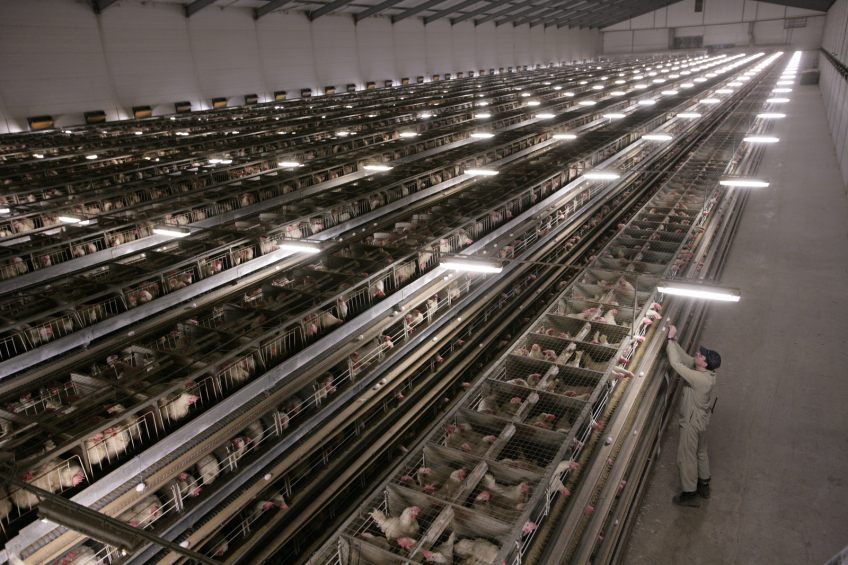Activists overthrow American cage farms

With Wal-Mart’s announcement, another big American company bids farewell to battery cage eggs. Opponents of cage production dominate the debate in the US, while poultry farmers are keeping a distance. Out of fear, says frontman Ken Klippen.
It is the big question in the ballot box in Massachusetts this November. Not whether Donald Trump or Hilary Clinton will be president of the United States. But whether the state will ban eggs that were laid in battery cages. The highest judge in Boston studies a signed request from the action group Humane Society of the United States (HSUS) to hold this referendum simultaneously with the elections. Although Massachusetts has only one laying farm, a ban includes the end of all sales of cage-eggs.
Animal activists control the debate
Diane Sullivan, poverty lawyer, and farmer James Dunn are trying to stop the referendum. But animal activists of the Humane Society control the debate in newspapers such as the Boston Globe and on national TV channels. By chance shocking photos taken on a laying farm in Maine showed up. An employee of Hillandale Farms, undercover for America’s largest animal activists club, filmed chickens sitting on top of dead conspecifics and birds barely able to reach feed or water.
Chicken drama fuels the flames
“Disgusting,” fulminates Paul Shapiro, director animal welfare at HSUS. The chicken tragedy generated interest from large news stations such as ABC and CBS. And although the company responded fiercely – the employee who was fired in the meantime was partly responsible for the mess himself – the media hype is precisely what the Humane Society is looking for in order to convince consumers. It has an annual budget of $135 million: enough for well-oiled campaigns. The crusade against the battery cage seems to be successful.
A few weeks ago Wal-Mart, America’s biggest retailer, announced they will only sell cage-free eggs from 2025 on. Last year McDonald’s made the same change. They all follow in the footsteps of sandwich chain Subway, which banned battery cages in 2010. The turn-around demands bigger changes among poultry farmers. Because currently only 10% of the America laying hens live outside cages. According to the Department of Agriculture USDA this concerns 18 million birds. While for the future demand 175 million are needed.

Poultry farmers silent
What is remarkable about the American battery cage discussion is that farmers don’t have their say in the media. The US Poultry & Egg Association, according to themselves are ‘the largest and most active poultry organization in the world’ appears invisible. Spokeswoman Gwen Venable cannot be reached. Why? Isn’t there a need for counterweight in the debate? Or does one think that, just like in Europe, nothing can be done? If it is up to Ken Klippen, chairman of the National Association of Egg Farmers, it definitely is not.
“When McDonald’s announced their part with cage-eggs, I immediately said I thought this was scandalous. Via a letter to McDonald’s and all national media. For many years we jointly researched the advantages and disadvantages of cage systems and free range in the Coalition for Sustainable Egg Supply. They know the results. You can’t tell the public you choose ‘based on health and food safety’. Because that crusade of activists is not based on science, but on a myth.”
Klippen speaks as chairman of the National Association of Egg Farmers on behalf of more than 200 companies. Together they account for 50 million hens and 10 billion eggs per year. “The risk of contamination with bacteria is bigger for free range eggs. One of the last Salmonella outbreaks was caused by a free range farm. Also, mortality is twice as high as in a battery cage. Consumers must understand that cage-free is not necessarily a heavenly system. But they hear something else.”
“Time after time I asked poultry farmers to share their story in interviews for American media. About the high investments. Or the facts on food security. But they don’t dare to do it. Among my members there is a fear that they will become the target of the same animal activists if they show up on television with their name and place. That is not a joke. With their aggressive performance they are capable of making it completely impossible to run a business.”
Ban not likely
A federal ban on the cage imposed by Washington, just as Brussels imposed 15 years ago in Europe, is not likely. But in Ohio for instance, the second largest egg producer, the new trend is tangible. According to the Department of Agriculture more entrepreneurs are orienting themselves on construction permits. “The costs are enormous. Refurbishing or building a barn costs millions,” says official Kevin Elder. Estimates of labour, construction, feed and drink materials and nests are around $40 per chicken. Not every farmer, especially not the smallest, can cough this up.
Eventually the price increase will end up on the consumer’s plate. And that is exactly what lawyer Diane Sullivan in Boston fears. A ban on cage-eggs makes it more difficult for vulnerable groups to get access to an affordable and healthy food product, says Sullivan. To her, vulnerable is not an abstraction, she has been homeless herself. Egg prices may increase by $0.12 – $0.80 per dozen.
Poultry farmer Amon Baer from Minnesota is considered bidding farewell to the cage. Just as his brothers and nephews with whom he is keeping more than one million laying hens. Yet, in an interview at Marketplace.org he says he decided not to do so for the time being. Mortality is an issue for him. But the biggest stumbling block is: “There is still no recognised standard what ‘cage-free’ is. Is it the enriched cage? Free range? If I invest $40 per chicken now and 5 years from now a certification body will say: “We do not accept this system.” And then, what should I do?”












